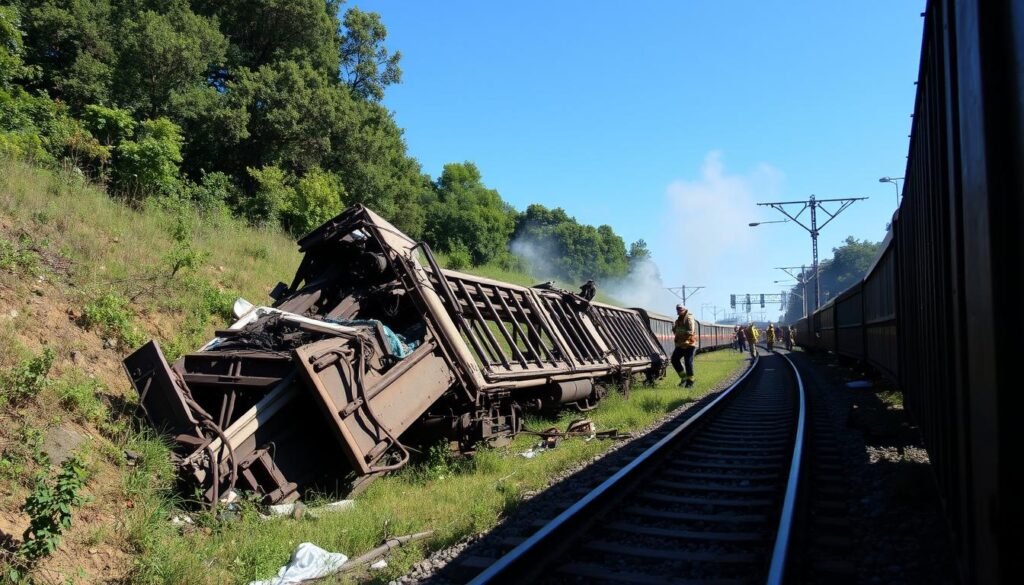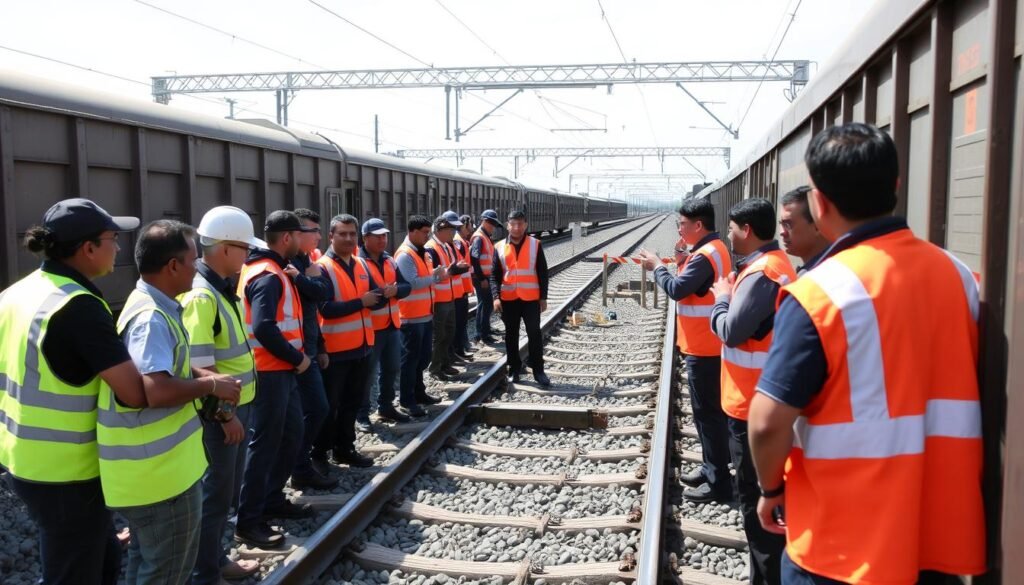Derailment Drama: Navigating Train Track Turmoil

Train derailments have become more frequent, highlighting railway industry challenges. These incidents underscore the need for safety, maintenance, and modernization in rail transport. Let’s explore the causes, consequences, and solutions to this growing issue.
Rail operators, regulators, and policymakers must work together to address derailment concerns. By examining root causes, we can develop strategies to enhance safety. This approach will help minimize disruptions and rebuild trust in train transportation.
Key Takeaways
- Train derailments have become a growing concern, with track-related issues, mechanical failures, and human factors contributing to the problem.
- Derailments can have devastating consequences, including fatalities, injuries, environmental damage, and significant financial costs.
- Effective crisis management and incident response are crucial for mitigating the impact of derailment incidents.
- Investing in modern infrastructure, advanced track inspection technologies, and comprehensive staff training can help prevent many derailments.
- Stricter safety regulations and government oversight can play a vital role in enhancing railway safety and public trust.
Train Derailments: Causes and Consequences
Train derailments pose serious risks, with many factors contributing to these disasters. Track-related issues, like track defects, are a primary cause. Improper track maintenance and environmental factors like extreme weather conditions can damage infrastructure.
Mechanical problems within trains can also cause derailments. Worn-out or damaged wheels may lead to instability. Malfunctioning brakes might fail to stop a train in time. Engine failures can result in sudden stops or loss of control.
Track-Related Problems: Defects and Maintenance
Poor upkeep of railway tracks increases derailment risks. This includes worn-out rails, loose bolts, or broken ties. Failing to enforce safety protocols and necessary upgrades can worsen track-related issues.
Mechanical Failures: Wheels, Brakes, and Engines
Excessive train weight or improper cargo distribution can make trains unstable. This is especially dangerous on curves. Signal and communication failures also pose serious risks.
“Derailments can cause injuries ranging from minor cuts to severe traumatic injuries, as well as psychological trauma.”
Derailment victims can seek legal remedies for their losses. This includes compensation for medical expenses, lost wages, and suffering. Attorneys play a crucial role in these claims.
Lawyers gather evidence, prove liability, and calculate damages. They also handle negotiations and represent victims in court. Their expertise helps ensure fair compensation for those affected by train derailments.
Human Factors in Train Safety
Rail safety requires attention to both mechanical and human elements. Human error, operator mistakes, and negligence have caused many train derailments. These incidents often lead to devastating consequences.
A tragic example occurred in 2013 in Santiago de Compostela, Spain. The derailment killed 79 people. The train was traveling at 192 km/h, twice the speed limit.
The driver received a work call minutes before the crash. This caused a “lapse of concentration” that led to the accident.
Train operators’ failure to follow safety protocols and conduct thorough inspections is common in derailments. The Federal Railroad Administration reports that human factors cause about 40% of rail accidents yearly.
These incidents have a psychological impact on front-line staff. After the Santiago derailment, the staff blamed themselves. This shows the emotional toll of such accidents.
The railroad industry faces growing demands. It’s crucial to have comprehensive training programs, safety protocols, and emergency preparedness measures. These can reduce human error and operator mistakes.
Addressing human factors can help create a safer rail industry. This approach aims to prevent the devastating consequences of negligence.
“The driver received a call on his work phone just minutes before the derailment, lasting nearly two minutes, during which he suffered a ‘lapse of concentration.'”
External Factors Contributing to Derailments
Mechanical issues and human factors aren’t the only causes of train derailments. External factors can also lead to these unfortunate incidents. Unpredictable events, like objects on tracks or sabotage, can have devastating consequences.
Obstacles on Tracks and Intentional Sabotage
Trains need a clear path to operate safely. Foreign objects on the tracks pose a serious threat. Vehicles, debris, or other items can cause derailments, endangering passengers and cargo.
Sometimes, these obstructions result from intentional sabotage. Individuals may place objects on tracks to disrupt operations. This malicious act can have severe consequences for train safety.
According to the latest data, the United States experiences over 1,000 train derailments annually, with track defects responsible for causing nearly 350 of the total incidents. Human error, on the other hand, contributes to close to 550 of the train derailments in the country each year.
Train derailments have decreased over the past few decades. However, external factors remain a concern. Railroads and authorities are enhancing safety measures to address these risks.
They’re implementing advanced track inspection technologies. They’re also strengthening security to prevent objects on tracks and sabotage. These efforts aim to improve train transportation safety.
“Unpredictable events, such as objects left on the tracks or intentional sabotage, can lead to devastating consequences for train operations.”
The rail industry continues to evolve. Addressing external factors is crucial for maintaining safe and reliable train transportation. This applies to both passenger travel and the movement of goods.
Tragic Toll: Injuries, Fatalities, and Environmental Impact
Train derailments can have devastating consequences. Lives are lost, and many suffer injuries. These incidents affect passengers, crew members, and nearby residents.
History has seen some catastrophic train-related disasters. In 1925, a Brazilian dynamite depot explosion killed over 600 people. The 1984 Bhopal disaster in India caused 3,787 to 16,000 deaths.
Bangladesh’s Rana Plaza collapse in 2013 led to 1,134 fatalities. These events show the immense human toll of such catastrophes.
Derailments can severely impact the environment, especially when trains carry hazardous materials. Chemical spills can contaminate soil and water sources. This contamination causes long-lasting harm to surrounding ecosystems.
The Chernobyl nuclear disaster released massive amounts of radioactivity. It forced the evacuation of 115,000 to 135,000 people within a 30 km radius.
| Incident | Location | Fatalities | Year |
|---|---|---|---|
| Explosion of Brazilian dynamite depot | Brazil | Over 600 | 1925 |
| Bhopal disaster | India | 3,787 to 16,000 | 1984 |
| Rana Plaza collapse | Bangladesh | 1,134 | 2013 |
| Chernobyl nuclear disaster | Ukraine | 28 (initial), 19 more by 2004 | 1986 |
These tragedies highlight the need for safety in transportation. We must prioritize preventing loss of life and injuries. Protecting the environment and managing hazardous materials is crucial.
Economic Repercussions of Derailment Drama
Train derailments can cause severe economic damage. Repair costs, service disruptions, and legal claims create lasting impacts. These disasters strain rail companies and nearby communities alike.
Repair Costs, Service Disruptions, and Legal Claims
Fixing damaged infrastructure and trains after derailments is costly. Norfolk Southern settled for $600 million over a hazardous chemical spill in East Palestine, Ohio. They’ve already spent $104 million on community aid and $4.3 million on water infrastructure upgrades.
Derailments disrupt services, affecting commerce, commuters, and the economy. In East Palestine, 50 residents remain displaced due to the incident. The town of 5,000 reported health issues like eye irritation and swollen lymph nodes.
Rail companies often face compensation claims from victims and families. Norfolk Southern’s settlement aims to resolve many lawsuits. However, Ohio’s Attorney General still has a pending lawsuit for environmental damages.
| Impact | Details |
|---|---|
| Repair Costs | Norfolk Southern spent $104 million on community assistance and $4.3 million on drinking water infrastructure upgrades in the East Palestine region. |
| Service Disruptions | An estimated 50 residents of East Palestine remain displaced due to the disaster, and the town has reported various health problems. |
| Compensation Claims | Norfolk Southern reached a $600 million settlement to resolve lawsuits concerning the East Palestine derailment, with more legal action pending. |
Train derailments have long-lasting effects beyond immediate costs. Cleanup, compensation, and health concerns can persist for years. This undermines public trust and economic stability in affected areas.
Undermining Public Trust in Rail Transport
Train derailments have shaken public faith in rail safety. These incidents cause injuries, deaths, and environmental harm. Many people now avoid trains, putting pressure on companies to boost safety.
Passengers once saw trains as safe and efficient. Now, they worry about their safety when riding. This change hurts rail companies financially, making upgrades harder.
Restoring trust in rail transport is complex. Companies must focus on safety and reliability. They need better track inspections, modern infrastructure, and improved signaling systems.
Staff training and emergency drills can help rebuild confidence. Rail companies and regulators must work together. They need to show a strong commitment to safety and openness.

“The erosion of public trust in rail transport is a complex issue that requires a multifaceted approach to address.”
| Factors Undermining Public Trust | Potential Consequences |
|---|---|
| Frequent train derailments | Reduced ridership, financial pressure on rail companies |
| Safety and reliability concerns | Hesitancy to use rail transport, negative perception of industry |
| Lack of investment in infrastructure and technology | Continued safety issues, further erosion of public trust |
Rebuilding trust in rail transport requires a thorough plan. This includes investing in new safety tech and updating infrastructure. Staff training and emergency readiness are also crucial.
These steps can help the rail industry regain public trust. They’ll also ensure trains remain a vital part of transportation.
Preventive Measures: Maintenance, Infrastructure, and Technology
Regular maintenance is vital for preventing train derailments. Advanced technologies can enhance these efforts significantly. Automated track inspection systems and predictive analytics help identify potential issues early.
These tools allow for proactive maintenance and timely repairs. This approach ensures the integrity and reliability of the rail network.
Advanced Track Inspection and Automated Monitoring
Modern infrastructure and sophisticated signaling systems boost rail safety. Upgrading tracks with high-quality materials improves network stability and performance.
Advanced communication technologies and automated monitoring systems reduce human error risk. They also improve response times during incidents.
Modernizing Infrastructure and Signaling Systems
Investing in regular maintenance, modern infrastructure, and advanced technologies prevents derailments. These measures ensure passenger and freight safety.
They enhance rail network reliability and build public trust in transportation. This proactive approach is crucial for the rail industry’s future.
“Predictive maintenance 4.0 goes beyond the hype and delivers results.”
Staff Training and Emergency Preparedness
Railway staff safety and preparedness are vital for reducing train derailment risks. Thorough staff training and regular safety drills boost rail transportation system resilience. These measures help staff respond effectively to emergencies.
Comprehensive Training and Safety Drills
Train operators and railway personnel need thorough safety education to reduce human error. Regular emergency protocols and simulations help staff develop crucial crisis response skills.
These exercises build muscle memory for effective action during emergencies. They also improve decision-making and coordination abilities in various derailment scenarios.
- Hands-on training in emergency procedures, including accident response, evacuation protocols, and first aid.
- Scenario-based simulations that recreate various derailment scenarios, testing staff’s decision-making and coordination abilities.
- Collaborative drills with local emergency responders to enhance cross-agency cooperation and communication.
- Continuous learning and feedback mechanisms to refine training programs and stay ahead of evolving safety challenges.
Investing in staff training and safety drills creates a culture of preparedness. This empowers railway workers to handle complex derailment incidents confidently and skillfully.

“Proper training and preparedness are the cornerstones of effective emergency response. By equipping our staff with the knowledge and skills to handle derailment scenarios, we can minimize the impact on public safety and the environment.”
Regulations and Government Oversight
Rail safety is a shared duty of companies and government. Strict standards, compliance, and audits protect the public from train derailments. These measures safeguard both people and the environment.
Recent incidents like the Norfolk Southern disaster have increased focus on safety. Investigations revealed track issues, mechanical failures, and poor oversight as contributing factors. These findings highlight the need for stronger government action.
| Regulatory Measure | Potential Impact |
|---|---|
| Mandatory installation of advanced braking systems (e.g., ECP brakes) | Reduced train stopping distances by up to 60%, potentially preventing accidents |
| Increased frequency of track inspections and audits | Identification and swift resolution of infrastructure issues before they escalate |
| Stricter enforcement of maximum temperature thresholds for wheel bearings | Timely detection and maintenance of critical mechanical components |
| Dedicated funding for rail infrastructure modernization and upgrades | Improved overall system resilience and safety |
The rail industry often resists new rules, citing costs and efficiency concerns. However, recent incidents show the urgent need for better safety measures. Policymakers must work with rail companies to balance profits and public safety.
Stronger safety standards and better compliance can rebuild public trust. Rigorous government audits will help ensure the railway industry’s commitment to safety. These steps are crucial for a safer rail system.
“Regulations are not the enemy of progress, but rather the foundation upon which we can build a safer, more resilient railway system that serves the best interests of the people.”
Derailment Drama: Navigating the Crisis with Collaboration
Train derailments are complex issues with many causes and severe consequences. Addressing root causes and implementing solutions can help reduce risks and improve rail safety. Collaboration between railways, government agencies, and industry partnerships is crucial for a safer railway system.
A train derailment triggers a crisis requiring swift, coordinated crisis management. Railway companies must work with stakeholders to minimize impact on operations, safety, and the environment. This involves open communication and a unified response to address immediate and long-term concerns.
Crisis exercises are effective for preparing for emergencies. These simulations test response plans and help identify gaps in strategies. Involving stakeholders like government agencies and emergency responders fosters collaboration and ensures a coordinated crisis response.
| Crisis Exercise Key Facts | Details |
|---|---|
| Duration | Typically 3-4 hours |
| Participants | Executive positions, senior operational leaders, specialist functions, third-party partners, board members, and the CEO |
| Scenario Complexity | Multiple layers, such as a major incident followed by a social media storm, pressure from journalists, safety inspections, fleet grounding, and customer complaints |
| Outcomes | Increased awareness of potential impact on the company’s brand, careers, legal, financial, and moral implications |
Collaboration and stakeholder engagement help railway companies tackle derailment challenges. Comprehensive crisis management strategies and investment in infrastructure can minimize risks. This approach enhances rail safety and reliability for everyone’s benefit.
Conclusion
Train derailments pose complex challenges for the railway industry. Addressing these issues requires a comprehensive approach. We must tackle track problems, mechanical failures, human factors, and external influences.
To prevent derailments, we need rigorous maintenance and infrastructure upgrades. Technological advancements and robust staff training are crucial. Emergency preparedness and stronger regulatory oversight are also essential.
Collaboration is key to improving railway safety. By working together, we can build a more secure transportation system. This will help cultivate public trust and minimize economic disruptions.
Our shared commitment to safety will create a stronger, more resilient rail network. We can face future challenges with confidence and better preparedness. Let’s work towards a future where train derailments become increasingly rare.
FAQ
What are the primary causes of train derailments?
Track problems like defects and misalignments often cause train derailments. Mechanical issues with wheels, brakes, and engines can also lead to accidents. These factors contribute to the risk of trains coming off the tracks.
How do human factors contribute to train safety issues?
Human errors play a big role in train safety. Operator mistakes, such as speeding or miscommunication, can cause accidents. Neglecting safety rules or skipping inspections also increases derailment risks.
What external factors can lead to train derailments?
Unexpected objects on tracks can cause derailments. These may include vehicles, debris, or even intentional sabotage. Such external factors are often hard to predict and control.
What are the tragic consequences of train derailments?
Train derailments can result in loss of life and injuries. Passengers, crew members, and nearby residents may be affected. Environmental damage can occur if hazardous materials spill.
Chemical or fuel leaks may contaminate soil and water sources. This pollution can have long-lasting effects on the surrounding ecosystem.
What are the economic repercussions of train derailments?
Derailments lead to high costs for repairing tracks and trains. Service disruptions affect commerce and daily commutes. Lawsuits and compensation claims from victims add to the financial burden.
How do train derailments impact public trust in rail transport?
Frequent derailments shake public faith in rail safety and reliability. This can lead to fewer people using trains. Rail companies face pressure to improve their systems.
What preventive measures can be taken to mitigate the risk of train derailments?
Regular maintenance of tracks and trains helps prevent derailments. Investing in modern infrastructure and signaling systems is crucial. Better training for railway staff improves safety.
Stricter government regulations and oversight can also reduce risks. These measures work together to create a safer rail transport system.





